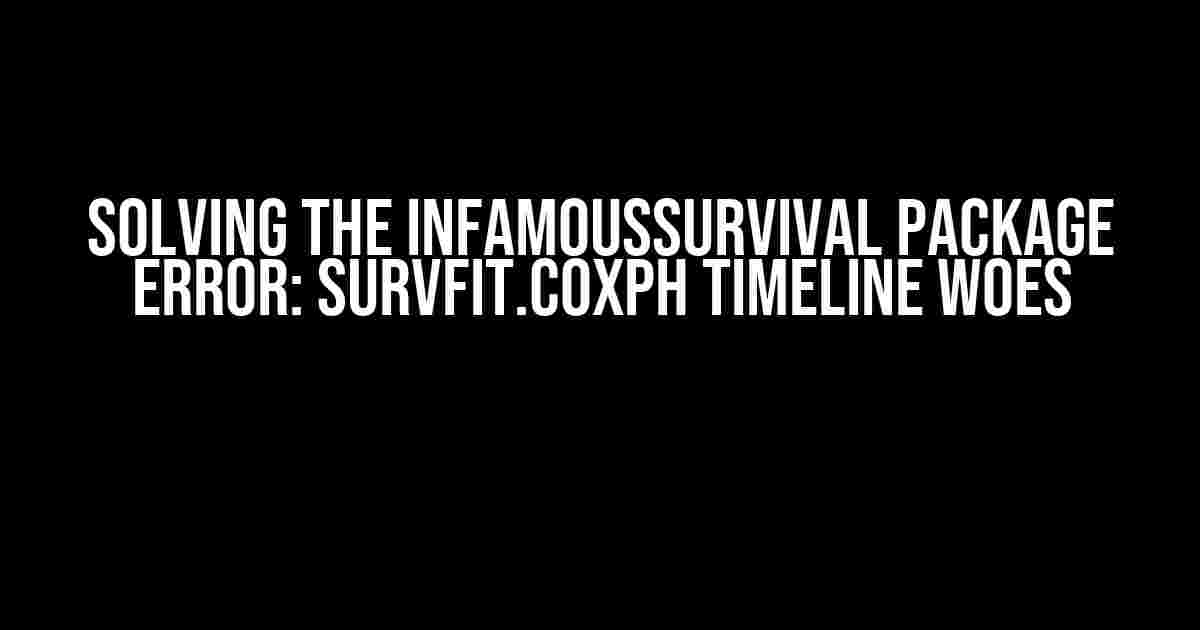Introduction
As a data analyst or researcher working with survival data, you’re probably no stranger to the R survival package. This powerful tool provides a vast array of functions to analyze and model survival data, but, like any software, it’s not immune to errors. One of the most frustrating errors beginners and seasoned pros alike encounter is the infamous “Survival Package Error: Survfit.Coxph” when working with timeline-style data. Fear not, dear reader, for today we’ll tackle this beast together!
What’s the Problem?
Before we dive into the solution, let’s first understand what’s causing this error. The `survfit.coxph` function is part of the survival package in R, which enables you to fit a Cox proportional hazards model to your survival data. However, when working with timeline-style data (i.e., where each observation has a specific start and end time), `survfit.coxph` can become finicky.
Typically, the error message will look something like this:
Error in Surv(rep(0, 100), c(1, 1, 1, 1, 1, 1, 1, 1, 1, 1, 1, 1, 1, 1, 1, 1, 1, 1, 1, 1, :
Time variable is not compatible with the event variable
This error occurs when the `survfit.coxph` function struggles to reconcile the timeline-style data with the event variable (i.e., the status indicator for censoring or failure).
Step-by-Step Solution
Don’t worry, dear reader! We’ve got a straightforward, step-by-step guide to conquer this error once and for all. Follow along carefully, and we’ll have you up and running with your Cox proportional hazards model in no time!
Step 1: Prepare Your Data
Before we dive into the `survfit.coxph` function, ensure your data is in the correct format. You should have:
- A start time variable (e.g., `start_time`)
- An end time variable (e.g., `end_time`)
- An event status variable (e.g., `event`)
- Covariates or predictor variables (e.g., `x1`, `x2`, …)
Here’s an example dataset:
| id | start_time | end_time | event | x1 | x2 |
|---|---|---|---|---|---|
| 1 | 0 | 10 | 1 | 3 | 5 |
| 2 | 5 | 20 | 0 | 2 | 4 |
| 3 | 10 | 30 | 1 | 1 | 2 |
Step 2: Create a Surv Object
Create a `Surv` object using your start and end time variables, along with the event status variable. This step is crucial for the `survfit.coxph` function to understand the timeline-style data:
library(survival)
surv_obj <- Surv(time = end_time - start_time, event = event)
Step 3: Fit the Cox Proportional Hazards Model
Now that we have our `Surv` object, we can fit the Cox proportional hazards model using the `coxph` function:
cox_model <- coxph(surv_obj ~ x1 + x2, data = your_data)
In this example, `your_data` is your dataset, and `x1` and `x2` are the covariates or predictor variables. You can add or remove variables as needed.
Troubleshooting Tips and Tricks
As you work with the `survfit.coxph` function and timeline-style data, you might encounter additional errors or issues. Here are some troubleshooting tips to keep in mind:
- Check your data format: Ensure your start and end time variables are in the correct format (i.e., numeric or Date objects). Verify that your event status variable is binary (0/1 or FALSE/TRUE).
- Verify your `Surv` object: Use the `summary` function to inspect your `Surv` object. This will help you identify any issues with the time variable or event status.
- Be mindful of NA values: If your dataset contains NA values, remove or impute them before creating the `Surv` object. NA values can cause issues when fitting the Cox model.
- Use the correct time scale: If your data is measured in different time scales (e.g., days, months, years), ensure you’re using the correct time scale when creating the `Surv` object.
Conclusion
Voilà! With these steps and troubleshooting tips, you should be able to overcome the `survfit.coxph` error when working with timeline-style data. Remember to prepare your data carefully, create a `Surv` object, and fit the Cox proportional hazards model using the `coxph` function. Don’t hesitate to reach out if you have further questions or need additional guidance.
Happy modeling, and may the survival analysis odds be ever in your favor!
Frequently Asked Question
Get ready to survive the errors in R’s survival package with these frequently asked questions!
Q1: What is the survfit.coxph function in R’s survival package?
The survfit.coxph function in R’s survival package is used to fit a Cox proportional hazards model to survival data and returns a survfit object, which contains the estimated survival curve. It’s a crucial function for survival analysis in R!
Q2: What type of data is supported by the survfit.coxph function?
The survfit.coxph function in R’s survival package supports right-censored survival data, where the event of interest (e.g., death) has not occurred for some observations. It’s perfect for analyzing data with censored observations!
Q3: What is the error message “Error in survfit.coxph(formula, data = data) : NA/NaN/Inf in ‘x'”?
This error message usually occurs when there are missing values (NA) or infinite/NaN values in your data, which the survfit.coxph function cannot handle. Check your data for any irregularities and clean it up before fitting the Cox model!
Q4: How can I fix the “Error in survfit.coxph(formula, data = data) : NA/NaN/Inf in ‘x'”?
To fix this error, try removing any rows with missing values (NA) or infinite/NaN values from your data using the na.omit() or complete.cases() functions. You can also try using the na.action argument in the survfit.coxph function to specify how to handle missing values!
Q5: What are some common pitfalls to avoid when using the survfit.coxph function?
Common pitfalls to avoid when using the survfit.coxph function include not properly specifying the formula, neglecting to check for missing values, and ignoring the assumptions of the Cox proportional hazards model. Make sure to carefully review your code and data before fitting the model!
